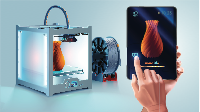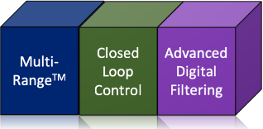What is 3D Printing?
3D printing is a manufacturing process that creates a physical object from a digital model file. The creation of a 3D printed object is achieved using additive processes. In an additive process an object is created by laying down successive layers of material until the object is created. Each of these layers can be seen as a thinly sliced cross-section of the object.
3D printing is the opposite of subtractive manufacturing which is cutting out / hollowing out a piece of metal or plastic with for instance a milling machine. In contrast, 3D printing enables you to produce complex shapes using less material than traditional manufacturing methods.
Most common types of 3D printers
3D printing is actually a ‘catch-all’ term that covers several types of additive manufacturing technologies and processes. There are at least 10 different 3D printing technologies available. While all of them can be used for rapid prototyping and rapid manufacturing, due to declining costs and advances in technology, some methods have also been adapted by hobbyists for home use, and light manufacturing in small businesses. These particular products are available in smaller desktop versions and are used for a wide array of applications including jewelry, dentistry, confections, fashion (e.g., sneakers) and toys.
The two most common types of 3D printers today are:
- Fused deposition modeling (FDM): FDM is also known as fused filament fabrication (FFF) and is the most widely used 3D printing technology at the consumer level. It works by extruding thermoplastic filaments through a heated nozzle, thus melting the material and applying it layer by layer to build the object.
- Stereolithography (SLA): SLA was the first 3D printing technology invented in 1986 and is still very popular especially for professional applications. SLA 3D printers work by curing liquid resin into hardened plastic in a process called photopolymerization. SLA is typically better than FDM for manufacturing complex parts and those that must be watertight or airtight.

Figure 1 – Desktop FDM 3D Printer
There are many other 3D printing technologies that can work with numerous kinds of materials besides plastics, such as metals, concrete, ceramics, paper and edibles (including chocolate!). Many of these require more specialized, and expensive, 3D printing equipment. Depending on your business needs, one of these devices may be a better fit than FDM or SLA-based printers.
Potential for Pressure Sensors in 3D Printers
It is easy to see the value that differential pressure sensors can bring to 3D printers. For starters we look at the nozzle where there is a need for consistent, predictable flow of material. Otherwise, you run the risk of having inconsistent material placement when building the object. For example, is filament or another object blocking the nozzle from operating as intended? Measuring the pressure of material disposition through the nozzle can easily let you know.
You also need to confirm that enough pressure (but not too much) is being applied by the ‘arm’ as you place one layer on top of the previous one. This makes sure that the layers bond well together. Otherwise, the object could become warped or lopsided. Here, a pressure sensor can be used to measure the arm pressure against the object as each layer is being applied.
Differential pressure sensors can also be used to confirm the structural soundness of the object as it is being built. If values fall outside the pressure parameters, the sensor can inform the printer to slow down the process so that existing layers have enough time to ‘cool down’ and harden. This will make sure that the object conforms to its original design parameters.
Finally, ensuring the structural soundness of the object during its manufacturing will reduce the need of printing support structures for any parts of the 3D model that hang outside of the core base. The pressure control coming from the differential pressure sensor will allow the printer to alter its speed until the placed materials are cured to the point of being able to support the overhang part of the structure. This reduces the amount of material needed to build the object and often results in a faster overall printing process since you eliminate the need to ‘print’ the support structures.
Superior Sensor’s NimbleSenseTM Architecture for 3D Printing
Having an extremely low noise floor, the NimbleSense architecture is ideal for the precise, low-pressure measurements that 3D printers require to maximize their accuracy and performance. However, the NimbleSense advantages extend beyond the low noise floor. Several of its application-specific building blocks provide additional value add for 3D printers.

Figure 2 – NimbleSense Building Blocks that can Benefit 3D Printers
Multi-Range TechnologyTM
Multi-Range technology allows one pressure sensor to operate at maximum performance over several different pressure ranges. Depending on the object being ‘printed’ and the materials used, the level of pressure required by the nozzle as well as the pressure needed for structural soundness will vary. Multi-Range allows one sensor to be adjusted ‘on the fly’ to meet the pressure requirements for that particular project.
Closed Loop Control
An integrated closed loop control can improve the reliability and speed/responsiveness of the 3D printer’s pressure sensing mechanisms. This capability significantly reduces loop delays and ensures accurate readings by directly controlling any motors, valves and actuators that control the nozzle, arms and other parts of the 3D printer.
Advanced Digital Filtering
3D printers are loud and subject to vibrations. Both factors that can impact the accuracy of pressure sensors. Utilizing our integrated advanced digital filtering technology, Superior’s pressure sensors eliminate the noise created by these factors prior to their reaching the sensor sub-system. Thus, the noise is eliminated before it becomes an error signal that can lead to inaccurate readings.
Conclusion
3D printers are changing the light manufacturing landscape. As they become more common in various market applications, the ability to ensure accurate material disposition and structural integrity will differentiate the best performing products from the rest of the field. Differential pressure sensors, particularly those from Superior Sensors, provide an easy, cost-effective solution.
To learn more about the NimbleSense architecture, please visit our technology page. If you have a 3D printer project you would like to discuss, please contact us.

